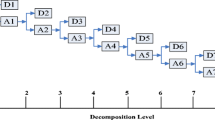Abstract
This work proposes a new blind digital audio watermarking system by using optimization-based modification on low-frequency amplitude of discrete wavelet transform (DWT). To modify the low-frequency amplitude under the best signal-to-noise ratio (SNR), the proposed embedding system minimizes the difference between the original and the embedded coefficients. Accordingly, an optimization-based embedding formula connecting the SNR and the embedding system is derived. The formula is then applied to embed the synchronization codes and the watermarks. Based on this formula, the number of DWT coefficients for embedding a binary bit can be increased to enhance the robustness without decreasing the audio quality. Consequently, the embedded audio has good quality and good robustness under high capacity. In addition, the system can extract the hidden data without the knowledge of original audio signal. Finally, the performance of the proposed watermarking method is tested. Experimental results indicate that the performance of proposed system is better than other DWT amplitude modification method.




Similar content being viewed by others
References
Gerzon, M. A., & Graven, P. G. (1995). A high-rate buried-data channel for audio CD. Journal of the Audio Engineering Society, 43(1/2), 3–22.
Bassia, P., Pitas, I., & Nikolaidis, N. (2001). Robust audio watermarking in the time domain. IEEE Transactions on Multimedia, 3(2), 232–241.
Gruhl, D. (1996). Echo hiding. In Proc. 1st Information Hiding Workshop, LNCS, vol.1174 (pp. 295–315). Berlin, Germany.
Zaidi, A., Boyer, R., & Duhamel, P. (2006). Audio watermarking under desynchronization and additive noise attacks. IEEE Transactions on Signal Processing, 54, 570–584.
Kim, H. J. (2003). Audio watermarking techniques, Pacific Rim Workshop on Digital Steganography. Kitakyushu: Kyushu Institute of Technology.
Alaryani, H., & Youssef, A. (2005). A novel audio watermarking technique based on frequency components. Proceedings of the Seventh IEEE International Symposium on Multimedia.
Boney, L., Tewfik, A. H., & Handy, K. N. (1996). Digital watermarks for audio signals. In Proc. 3rd IEEE Int. Conf. Multimedia Computing and Systems (pp. 473–480).
Ciloglu, T., & Karaaslan, S. U. (2000). An improved all-pass watermarking scheme for speech and audio. In Proc. 3 rd IEEE Int. Conf. Multimedia Computing and Exposition (ICME) (pp. 1017–1020).
Kim, H. (2000). Stochastic model based audio watermark whitening filter for improve detection. In Proc. 3 rd IEEE Int. Conf. Acoustics, Speech and Signal Processing (ICASSP) (pp. 1971–1974).
Ko, B. S., Nishimura, R., & Suzuki, Y. (2002). Time-spread echo method for digital audio watermarking using PN sequence. In Proc. IEEE Int. Conf. Acoustics, Speech and Signal processing, vol. II (pp. 2001–2004).
Lie, W. N., & Chang, L. C. (2006). Robust and high-quality time-domain audio watermarking based on low-frequency amplitude modification. IEEE Transactions on Multimedia, 8(1), 46–59.
Xiang, S., & Huang, J. (2007). Histogram-based audio watermarking against time-scale modification and cropping attacks. IEEE Transactions on Multimedia, 9(7), 1357–1372.
Huang, J., Wang, Y., & Shi, Y. Q. (2002). A blind audio watermarking algorithm with self-synchronization. In Proc. IEEE Int. Symp. Circuits and Systems, vol. 3 (pp. 627–630).
Wu, S., Huang, J., Huang, D., & Shi, Y. Q. (2005). Efficiently self- synchronized audio watermarking for assure audio data transmission. IEEE Transactions on Broadcasting, 51(1), 69–76.
Bender, W., Gruhl, D., & Morimoto, N. (1996). Techniques for data hiding. IBM Systems Journal, 35(3/4), 131–336.
Wu, C. P., Su, P.-C., & Kuo, C. C. J. (1999). Robust frequency domain audio watermarking based on audio content analysis. In Proc. Int. Symp. Multimedia Information Processing, ISMIP (pp. 37–45).
Li, X., & Yu, H. H. (2000). Transparent and robust audio data hiding in sub-band domain. In Proc. IEEE Int. Conf. Information Technique: Coding and Computing (pp. 74–79).
Wang, Y. (1998). A new watermarking method of digital audio content for copyright protection. In Proceedings of the. 4th International Conference on Signal Processing, vol. 2 (pp. 1420–1423).
Wang, X., & Zhao, H. (2006). A novel synchronization invariant audio watermarking scheme based on DWT and DCT. IEEE Transactions on Signal Processing, 54, 4835–4840.
Xiang, S., & Huang, J. (2007). Robust audio watermarking against the D/A and A/D conversions, CoRR arXiv:0707.0397v1.
He, X., & Scordilis, M. S. (2008). Efficiently synchronized spread-spectrum audio watermarking with improved psychoacoustic model, Research Letters in Signal Processing, vol. 2008, Article ID 251868, 5 pages.
Chen, S.-T., Huang, H.-N., Chen, C.-J., & Wu, G.-D. (2010). Energy-proportion based scheme for audio watermarking. IET Proceedings on Signal Processing, 4(5), 576–587.
Chen, S.-T., Wu, G.-D., & Huang, H.-N. (2010). Wavelet-domain audio watermarking scheme using optimization-based quantization. IET Proceedings on Signal Processing, 4(6), 720–727.
Lewis, F. L. (1986). Optimal control. New York: John Wiley and Sons.
Chong, E. K. P., & Zak, S. H. (2001). An introduction to optimization. New York: John Wiley and Sons, Inc.
Salovarda, M., Bolkovac, I., & Domitrovic, H. (2005). Estimating perceptual audio system quality using PEAQ algorithm. In 18 th International Conference on Applied Electromagnetics and Communications (IECCom2005) (pp. 1–4). doi:10.1109/ICECOM.2005.205017.
http://www.opticom.de/technology/technology.html: PEAQ information from OPTICOM.
Author information
Authors and Affiliations
Corresponding author
Rights and permissions
About this article
Cite this article
Huang, HN., Chen, ST., Lin, MS. et al. Optimization-Based Embedding for Wavelet-Domain Audio Watermarking. J Sign Process Syst 80, 197–208 (2015). https://doi.org/10.1007/s11265-013-0863-y
Received:
Revised:
Accepted:
Published:
Issue Date:
DOI: https://doi.org/10.1007/s11265-013-0863-y



